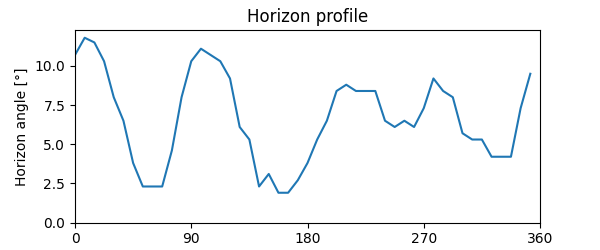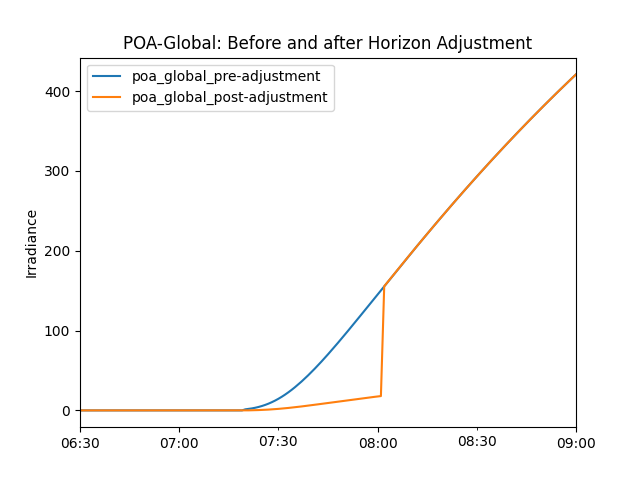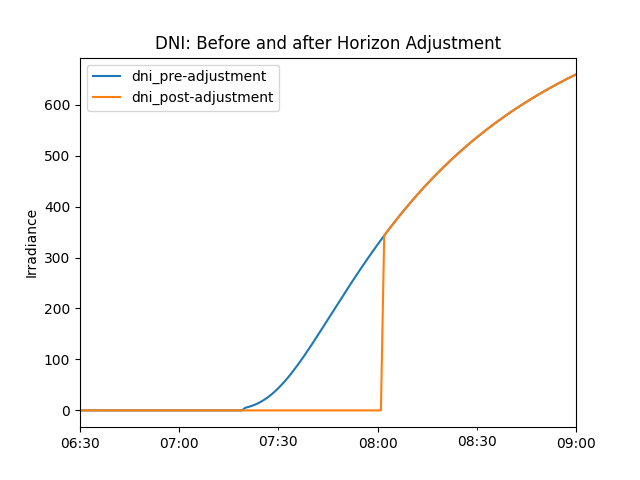Note
Go to the end to download the full example code
Simple irradiance adjustment for horizon shading#
Example of applying horizon shading to dni and global poa. Using horizon profile data, this example interpolates it to time-series solar-position data, and adjust DNI and POA-global irradiance.
This example shows how to use horizon elevation angles with corresponding horizon azimuth angles for simple horizon shading adjustments.
After location information and a date range is established, solar position
data is calculated using pvlib.solarposition.get_solarposition().
Horizon data is assigned, and interpolated to the solar azimuth time
series data. Finally, in times when solar elevation is greater than the
interpolated horizon elevation angle, DNI is set to 0.
import numpy as np
import pandas as pd
import pvlib
# Golden, CO
latitude, longitude = 39.76, -105.22
tz = 'MST'
# Set times in the morning of the December solstice.
times = pd.date_range(
'2020-12-20 6:30', '2020-12-20 9:00', freq='1T', tz=tz
)
# Create location object, and get solar position and clearsky irradiance data.
location = pvlib.location.Location(latitude, longitude, tz)
solar_position = location.get_solarposition(times)
clearsky = location.get_clearsky(times)
# Assign variable names for easier reading.
surface_tilt = 30
surface_azimuth = 180
solar_azimuth = solar_position.azimuth
solar_zenith = solar_position.apparent_zenith
solar_elevation = solar_position.apparent_elevation
dni = clearsky.dni
ghi = clearsky.ghi
dhi = clearsky.dhi
With basic inputs in place, let’s perform the adjustment for horizon shading:
# Use hard-coded horizon profile data from location object above.
horizon_profile = pd.Series([
10.7, 11.8, 11.5, 10.3, 8.0, 6.5, 3.8, 2.3, 2.3, 2.3, 4.6, 8.0, 10.3, 11.1,
10.7, 10.3, 9.2, 6.1, 5.3, 2.3, 3.1, 1.9, 1.9, 2.7, 3.8, 5.3, 6.5, 8.4,
8.8, 8.4, 8.4, 8.4, 6.5, 6.1, 6.5, 6.1, 7.3, 9.2, 8.4, 8.0, 5.7, 5.3, 5.3,
4.2, 4.2, 4.2, 7.3, 9.5
], index=np.arange(0, 360, 7.5))
ax = horizon_profile.plot(xlim=(0, 360), ylim=(0, None), figsize=(6, 2.5))
ax.set_title('Horizon profile')
ax.set_xticks([0, 90, 180, 270, 360])
ax.set_xlabel('Azimuth [°]')
ax.set_ylabel('Horizon angle [°]')

Text(28.972222222222214, 0.5, 'Horizon angle [°]')
Horizon data from PVGIS
Example of how to get the above horizon data from PVGIS
- horizon_profile, horizon_metadata = pvlib.iotools.get_pvgis_horizon(
latitutde, longitude)
# Interpolate the horizon elevation data to the solar azimuth, and keep as a
# numpy array.
horizon_elevation_data = np.interp(
solar_azimuth, horizon_profile.index, horizon_profile
)
# Convert to Pandas Series for easier usage.
horizon_elevation_data = pd.Series(horizon_elevation_data, times)
# Adjust DNI based on data - note this is returned as numpy array
dni_adjusted = np.where(solar_elevation > horizon_elevation_data, dni, 0)
# Adjust GHI and set it to DHI for time-periods where 'dni_adjusted' is 0.
# Note this is returned as numpy array
ghi_adjusted = np.where(dni_adjusted == 0, dhi, ghi)
# Transposition using the original and adjusted irradiance components.
irrad_pre_adj = pvlib.irradiance.get_total_irradiance(
surface_tilt, surface_azimuth, solar_zenith, solar_azimuth, dni, ghi, dhi
)
irrad_post_adj = pvlib.irradiance.get_total_irradiance(
surface_tilt, surface_azimuth, solar_zenith, solar_azimuth, dni_adjusted,
ghi_adjusted, dhi
)
# Create and plot result DataFrames.
poa_global_comparison = pd.DataFrame({
'poa_global_pre-adjustment': irrad_pre_adj.poa_global,
'poa_global_post-adjustment': irrad_post_adj.poa_global
})
dni_comparison = pd.DataFrame({
'dni_pre-adjustment': dni,
'dni_post-adjustment': dni_adjusted
})
# Plot results
poa_global_comparison.plot(
title='POA-Global: Before and after Horizon Adjustment',
ylabel='Irradiance'
)
dni_comparison.plot(
title='DNI: Before and after Horizon Adjustment', ylabel='Irradiance'
)
<AxesSubplot:title={'center':'DNI: Before and after Horizon Adjustment'}, ylabel='Irradiance'>
Total running time of the script: (0 minutes 0.436 seconds)

